Nomadness Walkthrough
2018 Note: The Amazon 44 named Nomadness has been sold, and this page gives lots of later details in addition to what appears in the 2010 article below.
This geek adventure platform is a bit different from those of my earlier (and more athletic) technomadic years. I spent over a decade with three versions of a computerized recumbent bicycle, toured on various kayaks, built an amphibian pedal/solar/sail micro-trimaran, and moved up to an outlandish 3-ton rocketship of a Corsair 36 tri… but I now find myself piloting an 18-ton steel pilothouse cutter with 60-foot bridge clearance and a 77-horse turbo diesel auxiliary. Sheesh. I do have a tendency to go for extremes, I know, but even this is a bit off the charts for one who has always been a multihuller and human-power purist.
Only recently have I been able to imagine myself at the helm of what I would have once dismissed as a lead mine. Stopping this baby in tight quarters takes finesse at the helm or some Dock Angels quick on the cleats, and it’s a far cry from my relatively lightweight Corsair 36. I could hop off an ama with bow and stern lines in hand, lead her obediently to the desired spot, and bring her to a stop with ease… and the sleek human-powered Microship that preceded that was based on a kevlar canoe, an order of magnitude lighter still. But piloting 36 thousand pounds of steel is another matter entirely.
Crazy it may be, but it was a solo venture to Desolation Sound in the Corsair that launched me in this direction. Fast, geeky, and sexy, she was a real head-turner… very much in the spirit of the preceding decade of development work here at Nomadic Research Labs (so much so that she was nicknamed Microship on Steroids). But practical for an extended expedition, or a full-time survival platform? Absolutely not.
Unwilling to go quietly to the dark side, I turned my attention for a while to catamarans… but never found one that was at once affordable and aesthetically appealing to me while also providing adequate headroom for the 6’4″ body that I should have gotten bonzai’d as a teen. (Even the monohulls that I began to consider presented problems in that department, although one honesty-impaired Seattle broker tried to convince me that insufficient headroom is a good thing: by using my head and neck muscles to brace in a seaway, hey, I could have both hands free!)
Once I thought it through, the eventual selection criteria for my escape pod were surprisingly clear: quality construction, less-than-absurd draft, a stout steel hull, excellent serviceability, pilothouse, survival tools like a watermaker and solar panels, room to add extensive geekery without having to destroy a work of art, and the ineffable rightness that ya just know when ya see it. After much research, I found the Amazon 44.
So… welcome aboard! Let me give you a look around…
Overview
Nomadness is a 44-foot steel raised-salon pilothouse cutter built in 1987 to the Grahame Shannon “Amazon 44” design by Dieter Pollack of SP Metalcraft of Vancouver, BC. She had a major refit in 2002, and has covered both coasts of North America including a couple transits of the Panama Canal. I believe I am the third owner.
Steel boats cover a very wide range, and to some extent have gotten a bad rap since so many are hard-chined homebuilts… with a corresponding uncertainty about the quality of materials, welds, and coatings. Even insurance companies are somewhat wary of them, and I had a thorough survey. The plating thickness is .2″ with very stout structure and deck backing, and the foamed insulation stops properly at the waterline.
Nomadness was built in a real shipyard, and has been well-maintained with robust coating systems, along with careful attention to galvanic action (and I have since added an isolation transformer). The rig, blessed by Brion Toss, includes a Hood in-mast furler that allows all sailing operations to be handled from the cockpit… with massive Barient 35 winches for the furling headsail. She’s actually cutter-rigged, though the inner forestay is currently stowed along with the corresponding jib.
Ground tackle includes a Lighthouse windlass, 300 feet of chain, and a 65-pound Bruce claw anchor… a nice combination (I also carry a smaller stern anchor as a backup). During the 621-mile shakedown in the late summer of 2008, we anchored in a wide variety of settings, rafted a couple of times, picked up a few mooring buoys, and poked our way into a dozen or so marinas.
She has a pilothouse, which is a wonderful thing, allowing control from inside when the weather is unpleasant. This one is a compromise; the design is sleek and sexy, but visibility through those low and sharply angled forward windows is not always as clear as I would like. When things are tricky, like picking my way through a sea of fishing floats, I can just saunter to the bow with the Bluetooth wireless remote for the Simrad autopilot.
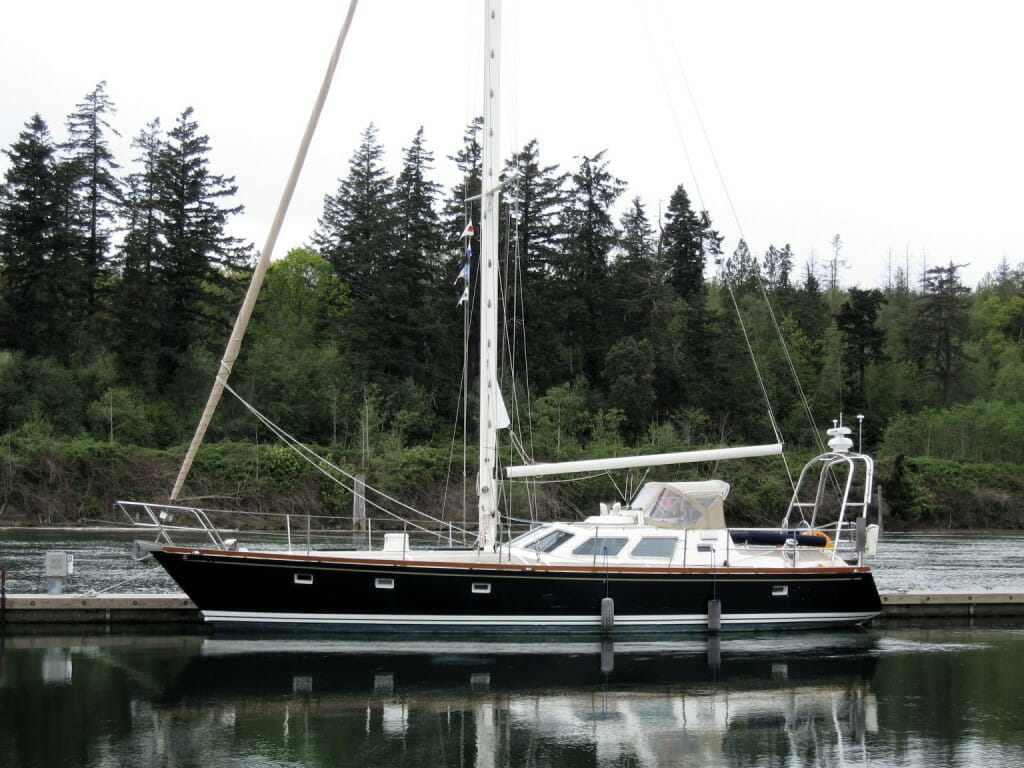
The default operating position is the helm back there at the stern, and the big change back there is a 420-watt solar array that interfaces with the stout radar arch. This adds solar and antenna mounting space, increases the sense of security, and provides weather protection for the helmsman… not to mention providing a major power source for the Outback charging system when off-dock.
The aft cockpit, like everything on a boat, is a trade-off. The well lowers the overhead space in the aft cabin (sleeping quarters only… gymnastics are out of the question). The eventual addition of a hard dodger will have the compensating effect of an “upstairs” pilothouse, increasing stowage and living space dramatically.
The arch is a key structure, and carries the dinghy that hangs from the davits whilst underway.
That dink is a Gig Harbor Navigator with forward-facing rowing system, a surprisingly capable sail rig, and a pair of Dinghy Dogs to provide flotation when most needed… and she is quite a delightful little sprite. I also carry a Hobie i12s inflatable pedal-kayak, but as any cruiser will tell you, the dinghy quickly becomes the “family car.” Most folks have a motor affixed to the transom for added practicality, and I have little 2.5 horse rig… but really, rowing is less hassle and I hardly ever use the outboard. (NOTE: in the photo above, I have the Dinghy Dogs installed upside-down… please don’t copy this! I need a good photo with proper installation.)
Interior
Let’s duck through the companionway and go below for a quick look. When I was first boat-shopping, I was more obsessed with accommodations than such details as length overall or even the type of rig, since a primary criterion was room for a proper lab. This had me looking mostly at 50-footers and up (even one monstrous Rhodes 65), but fortunately I came to my senses before buying something that would have been a maneuvering nightmare. With the “raised salon pilothouse” design, Nomadness actually crams quite a bit of useful geekspace into a modest 44 feet, while giving a sense of generous open space below.
I should mention a fundamental trade-off in interior design. Some boats have custom joinery that’s so freakin’ beautiful that the thought of tearing into it to make modifications is completely intimidating… like taking a Sawzall to a fine piece of antique furniture in order to convert it into a cabinet for a PC. At the other end of the spectrum is plain fiberglass with plastic doors and RV-scale fixtures; hacking into that is almost a pleasure because anything would be an improvement. I wanted something in between.
Nomadness is closer to the former, with her teak-holly sole and beautiful finish work… but much of the structure is beefy marine plywood. This makes additions relatively easy, even though I’m starting out with something that is quite lovely already. Here’s the original inside steering station and DC power panel, with Furuno Radar in between:
Actually, there’s a lot that is changing there… an instrument cluster at the upper left where that lone GPS is mounted, providing AIS and a window into the NMEA 2000 network including a Simrad autopilot… the old Robertson Autopilot that dominates the panel is being replaced by a sunlight-readable LCD for the nav Mac… and the power panel is being completely re-done with Blue Sea and Outback hardware. But this photo gives an idea of the interior finish work. Here is the new upper helm cluster:
I should back up a little. When you come down the companionway steps, you land in a big open space that combines piloting, engine room access, power management, nav station, and galley to port. Behind you through a door to starboard is the large but low sleeping cabin called the Cave; forward and down three steps is a hallway with dinette and entertainment area (along with a shower cabin and washer/dryer); further forward still is a classic V-berth cabin with its own head compartment. Here’s the wide-angle view upon entering the boat (this photo was taken by the listing agent before I came along):
The galley is immediately out of frame to the left, and in addition to the small DC refrigerator, there is a powerful AC cold-plate system with a top-loading fridge under the counter and a top-loading deep freeze under the chart table. It works so well that in the 2.5-month 2008 shakedown cruise, we had no trouble keeping staples like Haagen-Dasz, bagged ice, and frozen fish in stock. I have since added a stainless Breville espresso machine to the counter wing.
The original salon forward is becoming the lab and studio… with a desk that carries wrap-around rackmount consoles including a communications bay packed with radio gear, audio production tools, test equipment, and more. A full-size digital piano pulls out from under the desk, and the area across the hall is a standing workbench with good lighting and power tools. Here is the new desktop and integrated tool cabinet, before rack installation:
In the power domain, all management is handled by networked Outback gear, including a solar charge controller and system monitor display. The battery bank (690 amp-hours plus dedicated start batteries for both engines) is under the floor below the pilothouse table, and the two Yanmar diesels (77-horse turbo for propulsion via 3-blade Max-Prop, and a 3-cylinder 7.5 kW generator) are below the sole on centerline. One huge project that took place in my Friday Harbor lab facilities is a new power console:
And I’ve added a Little Cod wood stove off the end of the galley counter:
One of the things I am learning here is that living on a boat is an exercise in contortionism… a challenge for my bad back. Working on the engine is now incrementally more awkward, but it’s worth it… that cute little stove is a real powerhouse with 28,000 BTU capacity and the ability to serve as an auxiliary cooktop.
Indeed, comfort is a huge issue here. Gizmological urges aside, the ability to relax and feel cozy is of central importance when it’s cold and blustery outside… or even when you have just finished a hard sailing day and want to kick back and nurse a drink. This boat is a little marginal in that department, with lots of rather hard surfaces and stiff cushions. I’m making adjustments where I can.
Most of the control surfaces in the pilothouse are getting increasingly geeky, and systems, sensors, and video cameras are finding their way into almost every corner. There will, however, be a blinky-free zone in the forepeak… which has become known as the PENFA Suite. We were chatting with fellow owners of an Amazon 44 (rare birds, as I think only 9 were built), and strayed to the topic of maintaining relationship sanity in such a small space. “The pointy end’s not far away,” quoth Cindy in reference to the challenge of getting far enough apart on occasion, unwittingly generating an acronymic moniker for the Nomadness forward cabin.
There’s a lot more to talk about, but at this point the introductory tour ventures into rigging details, tankage, electronics, and other technical matters… I’ll save those for other articles in this series as well as the Nomadness Report. The bottom line is that she is a very solid and reliable substrate for the technomadic adventure tools, and performed well during the 621-mile shakedown adventure shown in this detailed map derived from the GPS datalogger and Google Earth. The next phase is system integration… then the real journey begins.
Cheers and fair winds from Nomadness…
– Steve


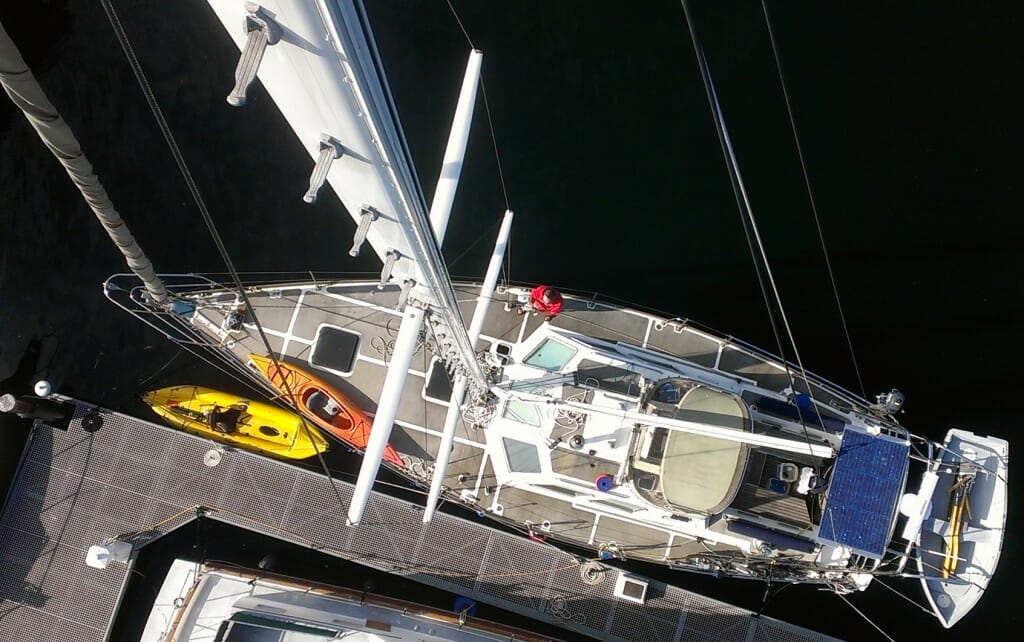
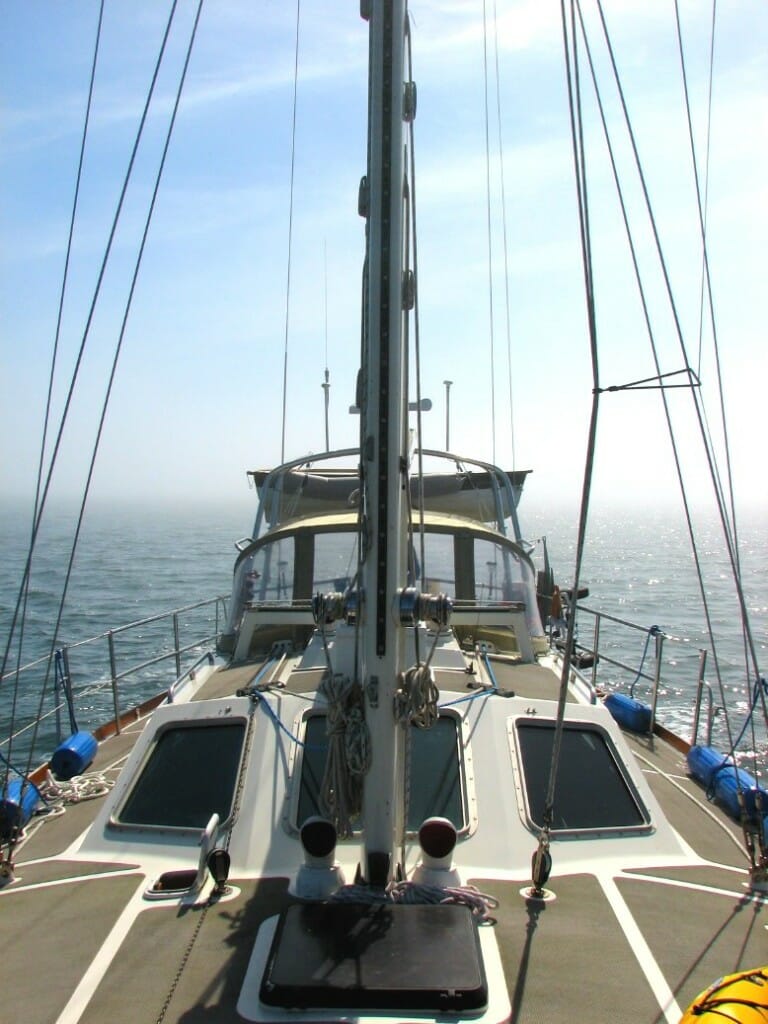
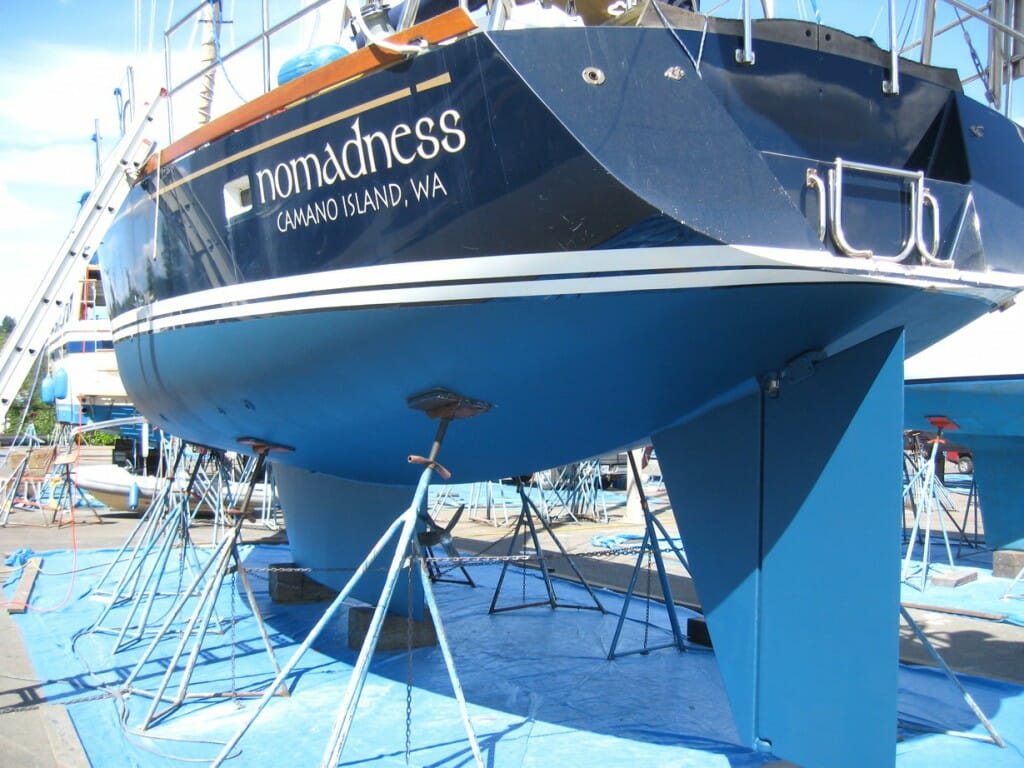
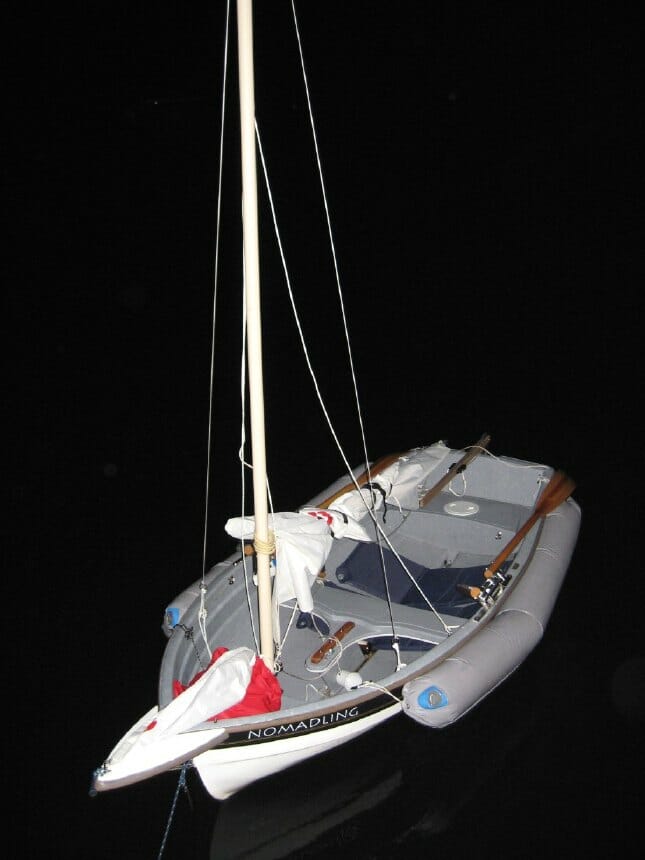
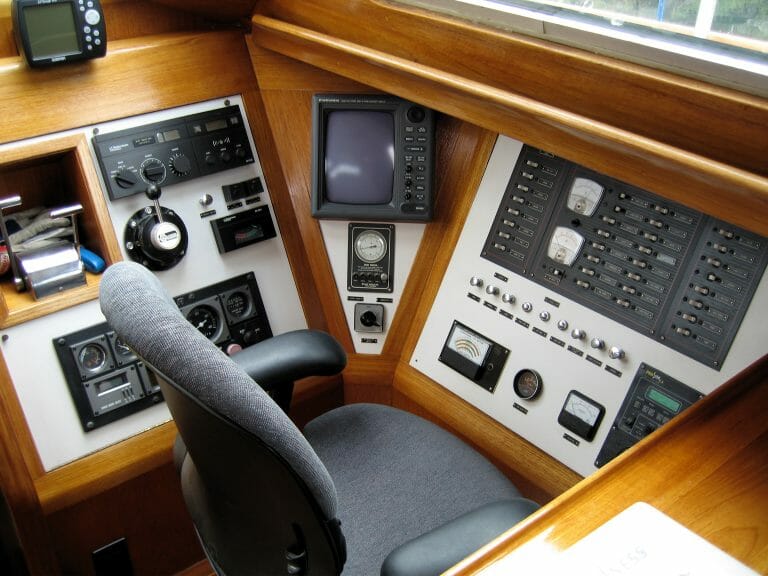
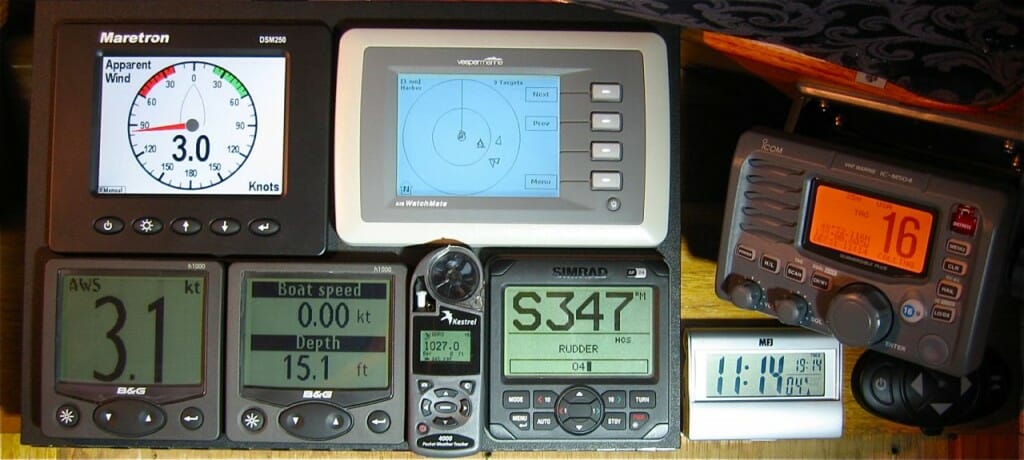

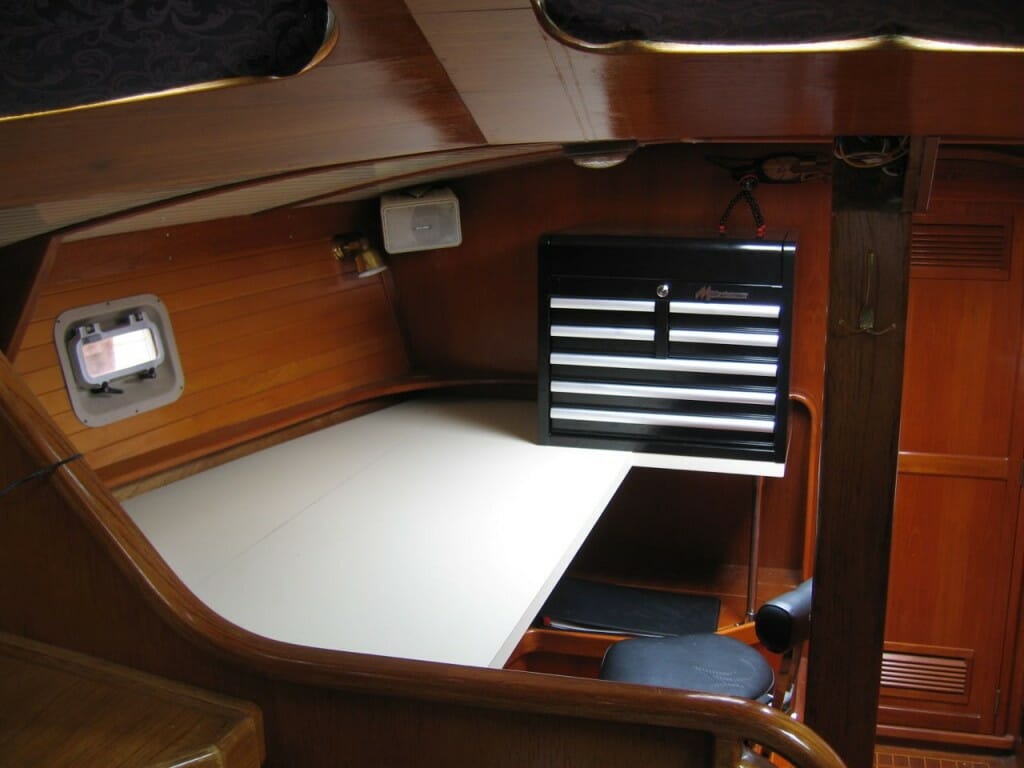
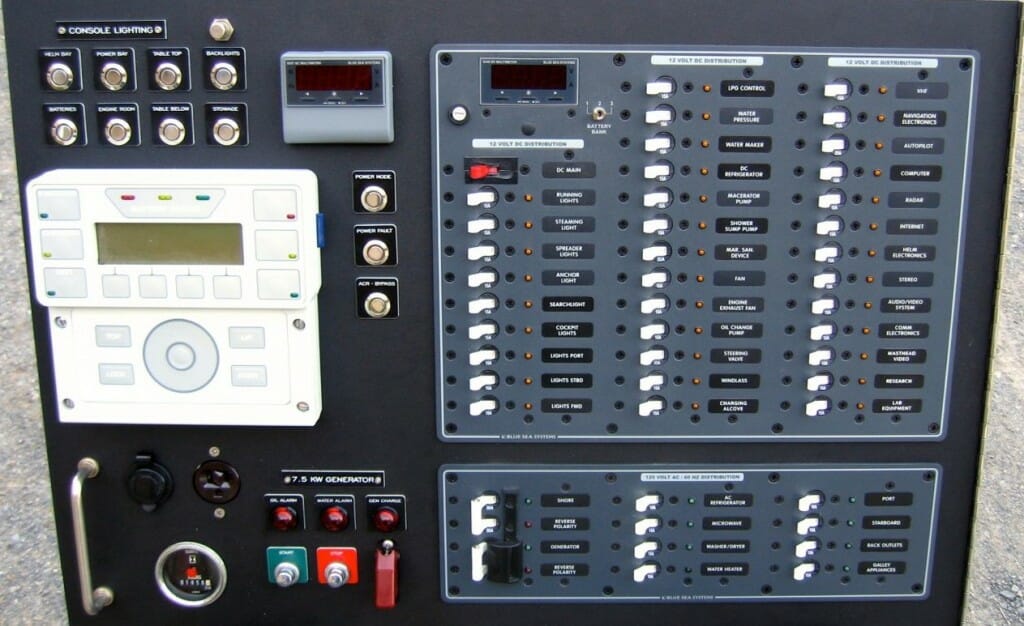
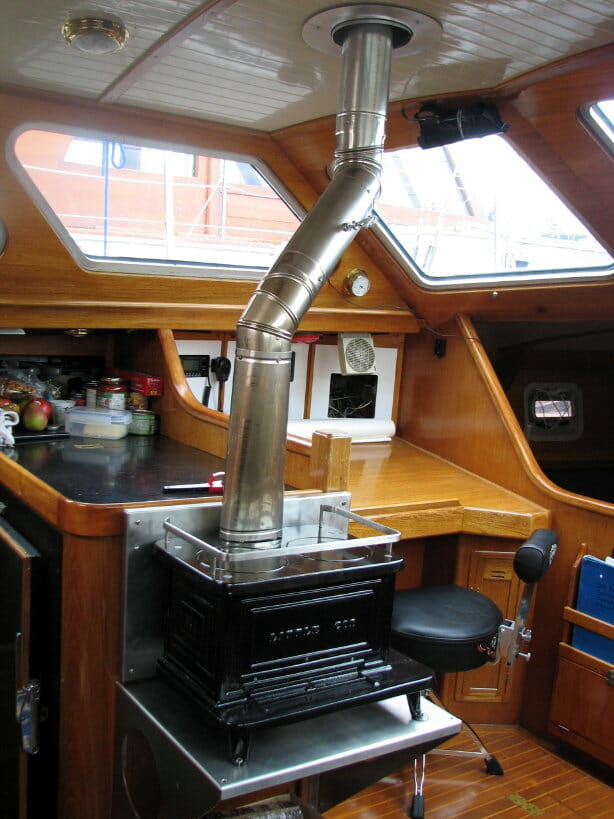
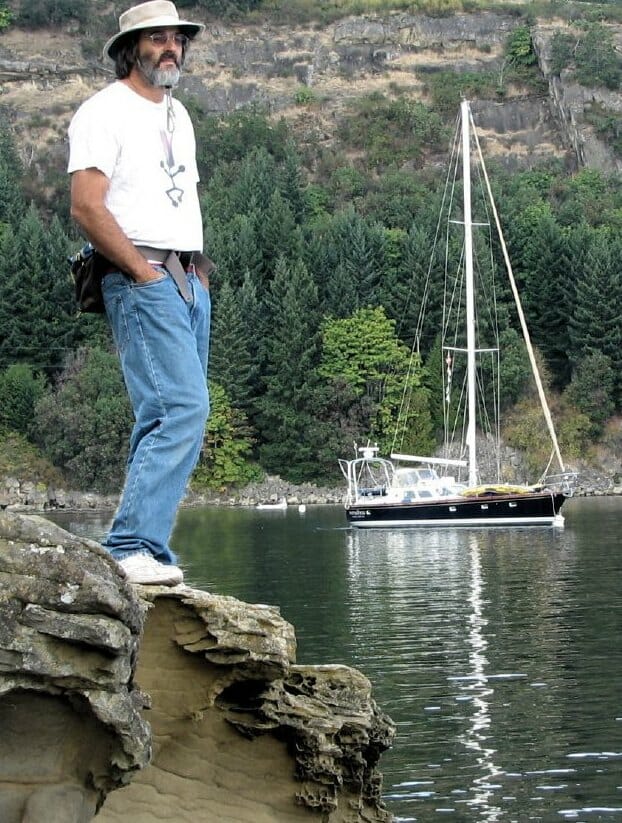
Just catching up on old posts. Have followed you for some time…enjoyable pastime. I would add that I am and continue to be impressed with your attention to detail. Far more than a hack job that is functional. It is aesthetically pleasing.
What a beautiful boat. I took lessons this summer and have my ASA certifications for renting a boat. A friend has a Pearson 26 that he doesn’t want so I am going to start sailing more and more on it to get my practice. I eventually want to live-aboard a boat also. Most I have seen are the typical style of fit as much crap into it as you can. Your boat seems to be more open.
Do you have any advice on living aboard and what to look for. Thanks for the tour- it is truly gorgeous!
Julian
Julian – thanks for the kind words about Nomadness!
Two resources I can suggest for researching the live-aboard life. Living Aboard Forum is quite good, and Cruiser’s Forum has much wider scope but some excellent live-aboard wisdom.
Cheers and fair winds!
Steve
About that reverse and low speed problem. Been there, done that. I’ve owned or operated boats similar to yours (kayak, Corsair, lead mine). The trick to maneuvering at low speed is (your gonna love this), throttle – lots of it. But in short bursts. Works like this: The boat is heavy, takes a long shove to get it moving. the water near the rudder is not as heavy, can be induced to move fairly quickly. So. A short strong burst of engine power will get the water flowing over the rudder, which is the key to controlling which way the boat is pointing. Have the rudder pointing where you want before throttle. Soon as the boat start moving, back to neutral. In tight quarters, neutral won’t be enough, you’ll need opposite thrust. Soon as the prop stops change gears, change rudder (opposite, remember) and a good strong burst in the other direction. You can make the boat turn in slightly more than it’s length.
Two other subjects, windage and prop walk. I’ll do windage. Prop walk you already know what to do. There are situations with wind/current where you won’t be able to get the bow going where you want it until you have considerable way on – more than you want in a marina. Hmm. Well, the boat will follow it’s prop, regardless of wind/current. So do it doggy style – backwards. Keep a firm hand on the tiller, it will want to slam over at about 2 kts in reverse. Also, keep in mind that the rudder is a wing, just like an airplane wing. If it’s too far from the line of travel it stalls and doesn’t provide lift. It just acts like a big brake. Keep the tiller within 10-15 deg of line of water flow, especially in reverse.
Enough for now. Good luck on this new venture.
Need this picture of the bottom to explain the maneuverability problem: https://microship.com/wp-content/uploads/2014/02/bottom-done-port.jpg
Relegates my previous post to the, “Oh, I didn’t realize that!” tag.
Good suggestion, Robert – done!
Thanks,
Steve
My Dear Nomadic Comrade,
It has been many years since our visit to the lab. It’s quite interesting catching up on your geekdomological adventure. Deb and I are still pursuing the RV-tecnomadnes lifestyle since our meeting in John Day back in 2000. You can see by a few details on my QRZ page, http://www.qrz.com/db/KB5HMU, that I am still enjoying the RV roving, amateur radio expedition journey. My RV-geekmobile has provided many days of adventurous land voyaging. I have pleaded with Deb many time to convert to the sailing lifestyle but can’t get her to agree to living in a cold damp environment (her description).
We purchased a home in the back country of the Bitterroot Valley in far SW Montana. Much of our summer is spent there with occasional sojourns in the RV. This 5200 foot high land of escape approaches the philosophic concept of living as a complete freeman. I love it. Our plans are to build an aquaculture building for food sustainability for ourselves and for marketing to or neighbors.
In order to continue the facilitate the pursuit of happiness, we still operate and grow our small renewable energy company in Yuma, Az. (www.starlightsolar.com) from November to May each year. Our speciality is in developing complete independence-minded power systems for those that have discovered the full-time RV lifestyle.
I hope to see you again in this great Life adventure and I wish you Peace and Success.
Your friend,
Larry, KB5HMU
Compliment, you have a very nice boat.
If one day you decide to sell, please, let me know.
Kind regards
Mario Zanasi
just loaded one (amazon 44) on a truck for delivery to washington, seattle, i belive. She’s one gorgeous monster! Boat left yesterday from jacksonville florida.
she is absolutely fantastic and the idea to put a wood stove in it, is original. my compliment for the article and for the photos
Nice meeting you with my engineer son on the dock last Saturday (11/26/11). My son and I enjoyed admiring your fine vessel and the conversation. You might remember that my sailing is now on a Tartan 34 C designed by Olin Stevens on the great Lake Champlain. My old boat does very well racing in Lake Champlain Yacht Club regattas. When I returned to Vermont I looked up “nomadness” web-site. Very interesting! If you care to read any of my books like “Growing Up In California,” Google Michael B. Barker for links.
Fair Winds!
Mike
Hey Steve (and David),
Just spending some down time on the web and came across this posting. Seems that gorgeous monster was Mentor! David was a great help getting her ready for the trip but I must say we wish she were still on the east coast. I think.
Best days of our lives were spent living aboard. NOTHING like the closeness and community of the cruising community!
The Nomadness is one of the best things on water I’ve seen. She is amazing and I feel good just watching photos and reading your article.
Wow. I recall reading about your bike trips when I was just out of college. Wasn’t the bike really heavy? 300 pounds? You must have been in really good shape.
The Nomadness is awesome. Video cameras is a good idea to offset the limited visibility from the cabin. In the book, “The New New Thing,” the author had a full Unix network with multiple servers that could control every aspect of the boat, including temperature on galley burners. Are you considering similar?
I’m a high tech business slave and envy you your nomadic lifestyle. YOLO.
Smooth seas and tail winds.
Mike
Hi Mike, and thanks for the note! Yes, a similar sort of plan, bringing lots of stray user interfaces and data points into a single database-backed server with web front ends… such a strange obsession. Of course, the longer it takes me, the more is available off the shelf… maybe the curves will cross while I’m sill alive *grin*
Cheers!
Steve
Was just made aware of your site by a colleague. Bicycle industry veteran (Bontrager, Bell Sports and CamelBak) and a sailor, currently living on an Alberg 35. I’ve dreamed of having integrated systems like you have, but time, money and shiny objects have all conspired to distract me from doing that. Look forward to crossing paths with you someday.
Thanks for the note, Chris! Were you involved with Bell during the Tourlite era? That was the substrate of my “Brain Interface Unit” – great helmet.
Hope to cross paths sometime as well! Fair winds from Nomadness….
Steve
I fell in love with your boat! However, like any schoolboy crush inadequacies come to the surface.
The only things I feel compatible with are the wind and the wood stove beautiful.
I wish I could pair up with someone who really knows what they’re doing to learn about her.
The engine alone is a nasa project to me …not a joke and I only wonder how she handles in wind does she lay gradual and come up easy. I am in awe and the explorer part of me that enjoys living on the water is very tempted to challenge myself and learn and grow more but I must admit I would need a mentor.
So good luck to you and your courageous spirit…as the gull calls and the sun sets may the ocean gently rock you in earth’s cradle to the scent of the salt air.
Blessings Sailor
Anthony